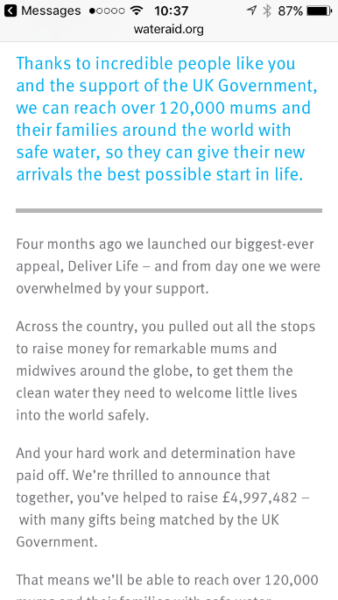SMS marketing has been around for over 20 years and most organisations now have well established mobile marketing strategies as part of their overall marketing mix.
But we’re still seeing some surprisingly poor practices. Some of these mistakes are minor but others will result in completely ruining an entire campaign.
So, to help you avoid some of the most common pitfalls, here’s our list of the top 6 SMS marketing mistakes.
Mistake # 1
Fail to use a URL shortener in your web links
Most SMS marketing campaigns will be encouraging customers to click through to a website. With just 160 characters in a standard text, every single one of them counts.
An easy and obvious way of maximising the number of characters you have available for your marketing message, is to shorten the website address using one of the many URL shorteners .
It’s an easy way to win back a few precious characters.
There are loads to choose from and they’re all free. Three of the most popular ones are,



Mistake # 2.
Send too many texts
If your initial SMS marketing campaign is successful and you’re delighted with the number of click throughs, phone calls or whatever you’re using to measure the campaign, it’s so tempting to swiftly follow it up with another campaign, to recreate the magic.
If you then achieve a lower response rate you may question whether the offer or the timing was wrong. So, you send out a follow up text which you’re convinced is even more responsive than the original.
You’ll probabaly then be underwhelmed with the reaction from your customers and rather alarmed by the number of unsubscribers?
What we have here is a simple case of SMS fatigue. You’ve annoyed your customers by sending them too many sales offers. Sending too many texts is is one of many surefire ways of encouraging your customers to unsubscribe.
A great benefit of SMS is that texts are never ignored. According to a Frost and Sullivan report, 98% of all texts get read, compared to just 22% of emails.
But this also means that if you bombard your customers, you’re likely to pay a price.
Less is most definitely more.
Mistake # 3.
Fail to Use an Opt Out
In most countries you are required by law to give customers an opt out on each marketing text that you send them.
Companies need to give a simple opportunity to refuse or opt out of the marketing, both when first collecting the details and in every message after that.
To opt out, the customer would normally just reply ‘stop’ to the text. It’s then up to the sender to apply an ‘opt out’ flag against that person so that they don’t receive anything else.
The opt out rules don’t apply to texts that aren’t selling.
So if you’re informing customers about credit levels or something relating to their account, then you don’t need to use an opt out.
Mistake #4
Send confusing Texts
A text contains just 160 precious characters. In that miniscule amount of text, your message has to communicate the following.
- Who you are
- Make an enticing offer
- Tell the customer how to respond
- Give an easy opt out route
Ideally this will all be done with charm, humour and a sense of urgency. It’s not easy.
The temptation is to investigate ever more cunning ways to reduce the number of characters you need for each part.
You can easily end up sending a text that’s exactly 160 characters but doesn’t make much sense
I recently received a marketing text from UK charity Save The Children, with weird unsubscribe instructions that I couldn’t make any sense of.
“To skip reply SKIP/call 02032827862 “
I had absolutely no idea what those instructions mean.
To avoid confusing your customers, use normal, jargon free language and keep abbreviations to a minimum.
Mistake #5.
Fail to optimise the web site for mobile
Most SMS marketing campaigns will be asking the prospect or customer to visit a website where they can find out more or respond to the offer in question.
It’s crucial then that the site you send visitors to should be properly optimised for mobile, offering the same experience that they would expect on the main site.
Surprisingly, many companies pay lip service to optimising their mobile sites.
Often the homepage will look impressive but deeper pages are made unusable by massive images or long and blocky text.
Before launching your SMS marketing campaign, make sure you’ve done thorough testing. Send the text to you and your colleagues. Click through to the website as you’re hoping your customers will.
- How was the experience?
- Did the site load quickly?
- Could you respond easily?
- Did the images look and feel right?
If the answer to any of those questions is no, then it’s time to press pause and get those issued resolved before sending out your message.
The charity WaterAid sent me a text quite recently with a link to their website. On clicking through, I was faced with page of more or less unbroken text.

To be fair, there were a few photos but I didn’t feel encouraged to discover more or click on further into the site.
We’re all becoming increasingly intolerant of thoughtless or lazy mobile design, so it’s vital that we take mobile optimisation more seriously and do the detailed work to make the whole mobile experience more exciting and responsive.
Mistake # 6
Don’t Segment Your Data
One of the most powerful benefits of SMS as a marketing tool is that it’s easy to adapt your offer to appeal to different customer demographics.
Most organisations hold vast amounts of customer data that can be segmented to make offers as relevant and as accurately targeted as possible.
So rather than sending everyone the same text, you can segment customers into broad categories, with each segment receiving a message that’s most likely to appeal to them.
Unlike every other direct marketing channel, there’s no additional cost in creating as many different offers as you wish.
So SMS can become the most targeted of all your marketing activity and if used conservatively will generate response rates that will outperform all your other marketing activities.